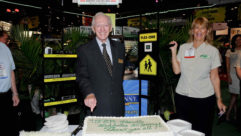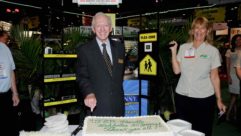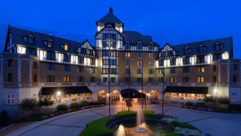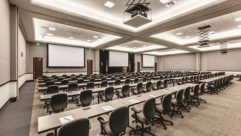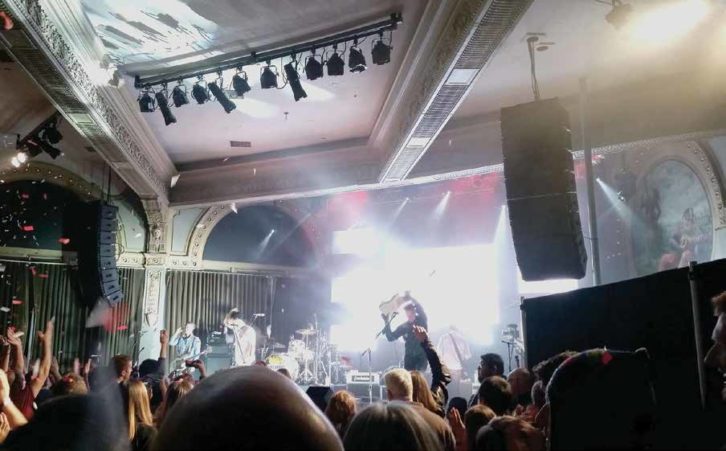
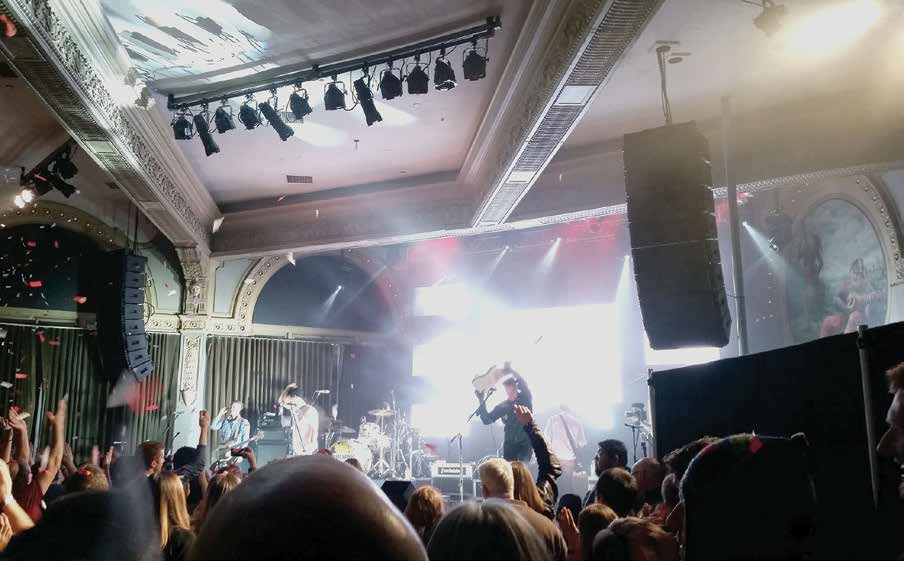
DSP has saved a lot of installs and will continue to do so. But when it comes to taming difficult rooms and delivering flexibility to multi-use facilities, the loudspeaker itself can be a powerful tool. In the hospitality industry, no room is more important to revenue and more challenging than the ballroom, whether it stands alone or is part of a hotel’s revenue model. This month we look at two installations in multi-purpose ballrooms where loudspeakers were the heroes–overcoming room configuration with physics to support a constantly changing variety of music, content types, and experiences.
Over a century ago, Ringler’s Cotillion Hall opened in Portland, OR. The Romanesque building, which is listed on the National Register of Historic Buildings, is now known as Crystal Ballroom. As such it served as a live music venue since the 1960s when it hosted performances from artists including the Grateful Dead, Ike & Tina Turner and Buffalo Springfield. The latest reincarnation of the ballroom began in 1997 when McMenamins, a family-owned Pacific Northwest hospitality business, acquired the structure. Now, the historic building has started a new chapter with a major audio equipment refresh, facilitated by design, sales, and integration company Tone Proper AV, located in nearby Gresham, OR.
The room, which accommodates 1,500 standing customers, presents acoustic challenges. The trapezoidal floor plan measures approximately 130 feet front to back and tapers significantly in width from the semicircular stage, tucked into a front corner, to the rear bar. Adding to the challenge, the angled wall features eight massive windows.

“If you were to install a traditional line array in this room, you would have wasted 50 percent of that array’s energy just blasting the glass,” observed Nick Moon, owner of Tone Proper AV. Moon had decided on a Bose ShowMatch system for the room. Working with Bose Modeler sound system software in consultation with the team at Bose Professional, he configured the left and right hangs with eight Bose ShowMatch modules each: six SM5 (with five degrees of vertical dispersion), one SM10 (10 degrees) and an SM20 (20 degrees) per array.
Critically, the horizontal waveguides on each module of the stage’s right array direct the energy away from the windows. “It’s asymmetrical, that blows people’s minds a little bit,” Moon says. The waveguides on the upper six SM5 boxes are set at 55 degrees and 70 degrees, and the SM10 and SM20 at the bottom are 100 degrees and 120 degrees, respectively.
“What’s cool is that they do it mechanically,” shared Moon, “not with DSP; a lot of manufacturers are going in the opposite direction. Doing it mechanically with the waveguide is cost-effective, and it works. And the proof is in the pudding, because we’re putting the energy where we want it and it sounds really good. Many experienced mix engineers have stated it’s the first time in that room that they’ve heard a stereo perspective; I agree.”
Twelve ShowMatch SMS118 subwoofers are ground-stacked six wide and two high against the curved front of the stage. “We time-aligned all of them and got everything phase-aligned,” Moon said. “We deployed a cardioid array to create a null at the lead singer position on stage. If you’re playing bass-heavy music and you’re where the singer is, it’s tight, not boomy.”
To cover those audience members standing front and center, Moon installed two SM20 modules for front fill; they sit atop the subs. “There’s a balcony about a hundred feet back where we have three Room Match Utility RMU208s providing under-balcony coverage,” he added.

This doesn’t mean there are no modern electronics of course.
“We’re running the whole thing bi-amped with 12 PowerMatch PM8500N amplifiers, so we’re able to do high frequency shading on each module,” said Moon. “We’re 10 dB away from clipping, so we have tons of headroom.” Processing for the PA includes a Bose ControlSpace ESP-00 II engineered sound processor configured with a single AES3 8-channel input card as well as one Dante card, one ESPlink 8-channel output card, two four-channel mic/line input cards, and two four-channel line output cards. This configuration provides a high level of flexibility for visiting engineers when they bring their own desks to the venue,” said Moon. “Bose ControlSpace software gives you the ability to really do whatever you want. They have limiters set to where they need to be, and we have a very modest EQ, along with the cardioid subs.
“ShowMatch is a very natural sounding box,” Moon concludes. “For a loud rock venue you can put a lot of power in a very small footprint.” Compared to the previous PA at Crystal Palace, “Everybody said it was a huge improvement.”
The Golden Globes is celebrating its 75th anniversary and has received an audio retrofit for its home at the renowned International Ballroom at the Beverly Hilton Hotel. Encore Event Technologies has purchased a new Meyer Sound LEOPARD linear sound reinforcement system to serve as the sonic foundation for production services it provides to the Globes and the wide range of events they support at the hotel. As the hotel’s resident production services provider, Encore supports more than 300 events annually, including such prominent entertainment industry gatherings the Academy Awards Oscar nominees luncheon, the Director’s Guild Awards, the American Cinema Editors’ Eddie Awards, the Visual Effects Society awards, and the Clive Davis Pre-Grammy Party, as well as myriad events that demand support for music, spoken word, and broadcast.

Performance requirements for the audio system are exceptionally challenging as it must supply crisp speech intelligibility for up to 1100 guests along with the power reserves and musicality needed for live music performances – often from A-list artists—as well as convincing reproduction of the high-impact soundtracks accompanying clips from Hollywood releases. All these factors were considered by Rachel Wolfe, director of event technologies at Encore’s Beverly Hills location, in making her selection of the LEOPARD-based system.
“We had a Meyer Sound MICA system in here for about ten years and we were pleased with its performance,” says Wolfe, “but I felt like it was time to invest in newer, updated technology. I’d heard LEOPARD at other venues and was convinced it was the right choice. The power and clarity are all I expect from Meyer, and LEOPARD’s wide coverage works well with the shape of the room. Also, the slender profile of the arrays is visually appealing and fits in well with our other staging requirements.”
Clint Rowland, a freelance FOH engineer frequently contracted by Encore to mix events at the venue, admits he was both excited and hesitant when the LEOPARD system made its debut. “I was somewhat nervous because I had relied on the MICA loudspeakers for the six years I had worked here,” he says. “But I was relieved and excited when I first started pumping music through it. I was even more impressed when they put up a podium mic and then walked around with a wireless lav. This is a tricky room to work in, with a low ceiling that’s covered with video and lighting gear, and layout changes drastically with different events. But LEOPARD is giving us great sound and superb gain before feedback.”
Rowland says he likes how LEOPARD responds to the full spectrum of program material and output levels. “With LEOPARD, it doesn’t matter if we’re doing a corporate show with talking heads, or a fundraiser with A-list bands, or an awards show. The volume level does not affect the tonality. You can mix a low volume presenter and then move to a dinner band, then on to a full rock performance or action movie soundtracks. Whatever you do, the system behaves in a linear fashion. You don’t have to push it to a certain volume to get the sound you want. You get ‘power without the pain’ as one of my colleagues likes to say.”

Provided by Chicago-area integrator TC Furlong, the new audio reinforcement system is anchored by dual arrays of six-each LEOPARD line array loudspeakers and supplemented in sub-bass by four 1100-LFC low-frequency control elements. (The complete Meyer Sound roster also includes 11 UPJ-1P VariO loudspeakers and four UPM- 1P loudspeakers, one MM-4-XP self-powered loudspeaker, and four MJF-210 stage monitors).
The recent audio renewal by TC Furlong also included installation of a new Yamaha Rivage PM10 digital mixing console. Other production technology available from Encore at the International Ballroom includes six Christie Roadster 14K HD LCD projectors, a permanent lighting grid with over 350 fixtures (moving lights from Vari-lite, Quantum and GLP), and high-speed networking including SMPTE fiber connection.
Furlong explains how for a multi-purpose environment, LEOPARD’s fierce linearity in frequency and power response is critical. “It also has a lot of rear rejection—which you want with a broadcast application, and you want linearity off the front; you don’t want to have to fight to control lumps and bumps. And often you want to be able to turn things down and not lose fidelity.”
In live music, he says, mixers dream of wide horizontal dispersion so they’re hitting all the seats. “LEOPARD has very wide horizontal dispersion, but if the room geometry doesn’t accommodate the wide angle, LEOPARD’s linearity ends up playing nice with the walls. You don’t get mid-range only bouncing off the walls.
“This is the most linear loudspeaker I’ve ever used. Which means the guest experience can be in the hands of the mixer where it belongs.

“People don’t always know why a loudspeaker makes them feel at ease,” Furlong concludes, “but in my opinion, after 25 years of doing this, distortion is what makes people uncomfortable in a space. Meyer has really tackled that last frontier which is removing distortion from their loudspeakers. LEOPARD is incredibly low distortion, which makes it sound equally fantastic at low and high volumes. It more faithfully reproduces the intent of the mixer.”
PRODUCT AT WORK
MEYER SOUND LABS LEOPARD

This patent-pending compact linear array brings the precision and headroom of the company’s LEO family to a compact and flexible form factor suitable to a very wide range of rooms, and material from spoken word to most types of music.


